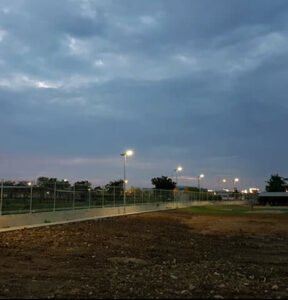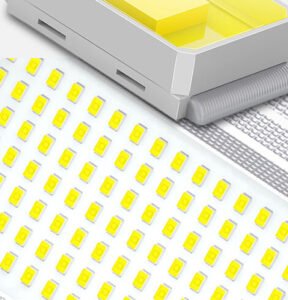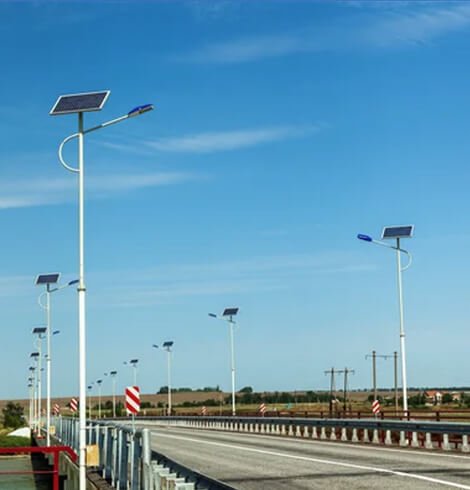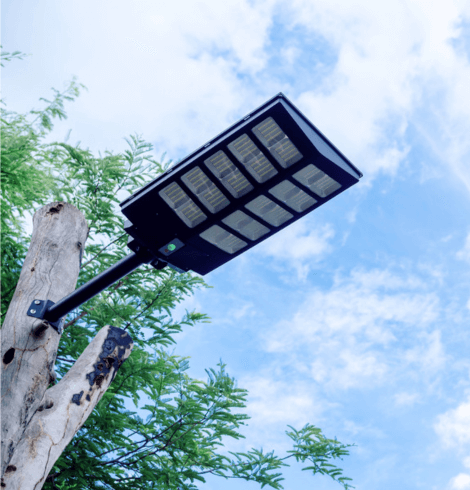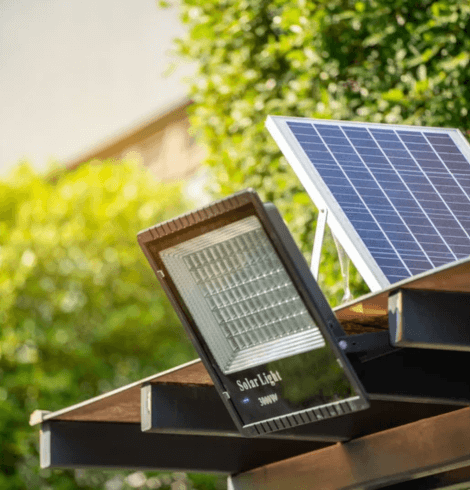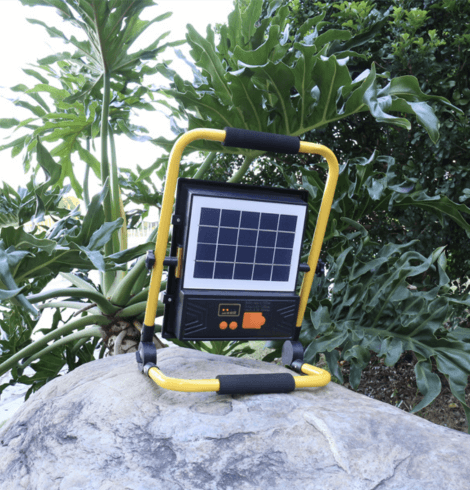When people ask, “How long will a solar street light last?”, the honest answer is — it depends on the parts, and how they’re maintained. In this guide, we’ve broken it down component by component:
- Solar panels can easily last 20 years or more, with slow, predictable performance drop-off.
- Batteries are typically the first to need replacement — usually every 5 to 8 years.
- LED light sources often exceed 20 years of use, with minimal brightness loss.
- Controllers generally hold up for 8 to 10 years, provided they’re well protected and properly installed.
- Poles, if galvanized and inspected occasionally, can remain structurally sound for 20–30 years.
Taken together, a well-built solar street light system can run for decades — especially if you plan for battery and controller swaps along the way.
Want to know how we get there? In the sections below, I’ll walk you through each key component of a solar street light and explain how long each typically lasts, what affects their performance, and what you can do to keep the system running at its best. If you’re planning, maintaining, or just evaluating solar lighting, these details will help you make better long-term decisions.
Table of Contents
ToggleWhat Determines the Lifespan of a Solar Street Light?
In my experience working with clients across different regions and projects, one question comes up again and again: How long do solar street lights actually last? It’s a practical concern — especially when you’re planning for long-term performance in public or commercial spaces.
The truth is, there’s no single number, because these systems aren’t just made of one part. A solar street light includes a solar panel, a battery, an LED light source, a controller, and a pole — and each of these has its own expected lifespan. How well the system holds up over time depends on how these parts are built, how they’re used, and how they’re maintained.
In this guide, I’ll walk through each of these components, explain how long they typically last, and share a few ways you can help them perform longer. Whether you’re designing a lighting plan, overseeing installations, or just learning more about solar lighting, this breakdown should give you a clearer picture of what to expect — and how to get the most out of your system.
Solar Panel – 20+ Years (with Gradual Attenuation)
Let’s start with the component that usually lasts the longest: the solar panel.
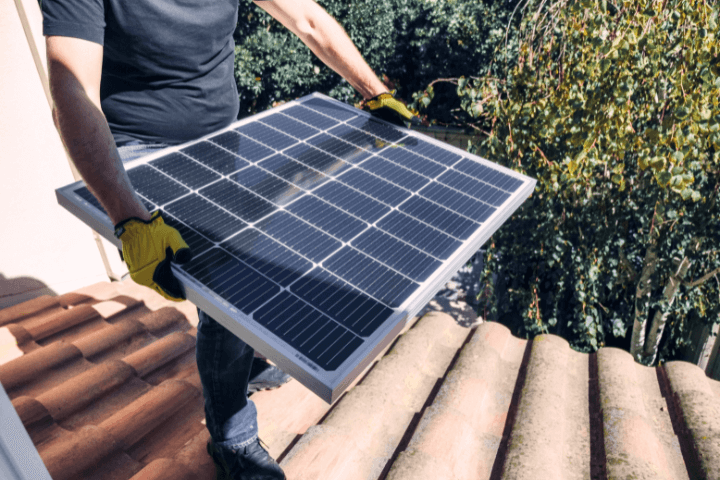
This is the part that converts sunlight into electricity — quietly, efficiently, and every single day. High-quality photovoltaic panels are built to last. In most cases, they continue working for over 20 years. Even after two decades, you can still expect 70–80% of the panel’s original output.
That gradual decrease in energy production is called attenuation, and it’s completely normal. A 30% drop over 20 years is typical, but the panel itself will likely keep going far beyond that.
How does it affect the lifespan of the solar street light system?
In practical terms, it means the solar panel is almost never the first thing to fail. If you’re aiming for a system that runs reliably over the long term — say, 15 to 20 years — a durable, high-efficiency panel gives you a strong foundation. It keeps energy flowing year after year, which is especially important for public infrastructure or large-scale lighting projects.
Maintenance Tip
If you want to get the most from your panel, it’s worth paying attention to a few small things.
Dust, leaves, or even bird droppings can reduce energy absorption — sometimes more than you’d expect. I recommend cleaning the surface regularly with a soft cloth and mild detergent. Don’t use anything abrasive that might damage the surface coating.
Also, take a look around for shade. Nearby branches or buildings casting even partial shadows can impact performance throughout the day. Keeping the panel exposed to full sunlight helps maintain steady output and slows down long-term efficiency loss.
Lithium Battery (LiFePO₄) – ~5+ Years
Now let’s look at the component that often defines how long the system stays fully functional: the battery.

While solar panels tend to outlast everything else, the battery typically wears out first. Most modern solar street lights use lithium-ion batteries — and more specifically, lithium iron phosphate (LiFePO₄) — because they offer much better stability, cycle life, and temperature resistance compared to older lead-acid models.
A LiFePO₄ battery usually lasts between 5 and 8 years, depending on how it’s used and the environment it’s in. Most are rated for around 2000 charge–discharge cycles, which roughly equals five years of daily operation before the capacity begins to drop noticeably. For context, traditional lead-acid batteries tend to last only 2 to 4 years under similar conditions.
How does this impact the overall system lifespan?
Because the battery is the first component to degrade, it’s often the one that determines when maintenance is needed. As battery performance declines, the system might not store enough energy to keep the lights running through the night. This can lead to shorter lighting hours — something municipalities and property managers need to plan for.
The upside is that battery replacement doesn’t mean replacing the whole system. One of the advantages of solar street lights is their modular design: when the battery reaches end-of-life, you can replace just that part. With proper upkeep, the rest of the system — including the panel, controller, and LED light — can keep running for many more years.
Maintenance Tips
To protect battery life, avoid installations in areas with extreme heat or freezing temperatures. While most batteries are housed in insulated or ventilated enclosures, location still matters. Keeping the system out of harsh thermal conditions can noticeably extend battery performance.
It’s also important to monitor battery health regularly. Most smart controllers display battery status or alert you to performance drops. If the lights are dimmer or don’t stay on as long, it could be a sign that the battery is approaching the end of its cycle life. Follow the manufacturer’s guidelines for inspection and replacement, and always make sure the battery housing is sealed properly to prevent moisture or corrosion-related damage.
LED Light Source – Up to 20+ Years
After the battery, the next component to consider is the LED light itself — and here, the outlook is strong.

Thanks to advancements in LED technology, today’s solar street lights are equipped with luminaires that last far longer than older lamp types. Most high-quality LED modules have a theoretical lifespan of around 50,000 hours — which translates to over 10 years of non-stop operation. But since street lights only run at night (typically 8 to 12 hours), that same LED can realistically last 20 years or more under normal use.
In real-world installations, especially in municipal settings, it’s common for LEDs to remain functional for 20 to 25 years before their brightness declines noticeably. Light decay is minimal — often just 2–3% per year — which means they maintain their output far better than older sodium or halogen lamps.
What does this mean for system longevity?
Simply put, the LED light source is one of the longest-lasting parts of the entire system. With proper heat management and a quality driver, it rarely needs replacement. That’s a major advantage for public lighting projects, where fewer site visits and replacements mean lower operating costs over time.
From a sustainability standpoint, the extended lifespan of LEDs also means less material waste — fewer failed bulbs to discard, and a lower environmental footprint over the system’s lifecycle.
Maintenance Tips
LEDs are low-maintenance, but not maintenance-free. Heat is still their main enemy. Even though they generate less heat than traditional bulbs, it’s important to keep their heat sinks or ventilation paths clear. If dirt or debris builds up, it can limit cooling and shorten component life.
Also take a moment to check the lamp cover from time to time. Dust or insects can build up and block light output. A quick clean with a soft cloth helps preserve brightness.
And if you ever notice a sudden drop in light levels, it might not be the LED itself — the driver (which regulates power to the LED) could be the issue. A quality LED driver is just as important as the light source, and ideally it should last just as long. If something seems off, checking with the manufacturer is always a smart move.
Controller – 8–10 Years
After the light source, it’s worth turning attention to the controller — the part that quietly keeps everything running as it should.

The controller acts as the “brain” of the system. It manages the flow of electricity from the solar panel to the battery, and then from the battery to the LED lamp. It also decides when the light turns on and off, often using smart charging methods like MPPT (Maximum Power Point Tracking) to improve efficiency.
A high-quality controller is typically sealed against moisture and designed to handle outdoor conditions. In most cases, it can operate reliably for 8 to 10 years. That said, actual lifespan depends on the quality of internal components and how much environmental stress (like heat or humidity) it’s exposed to. In standard use, I’ve seen many last well beyond 5 or 6 years without issue.
What role does it play in long-term reliability?
If the controller fails, the system stops functioning — charging halts, lighting shuts down. That’s why reliability here is critical. A controller that’s well-made and properly installed can run for years without attention, but a poor-quality unit is more likely to fail early and silently.
For larger projects, I’ve seen municipalities opt for controllers with built-in remote monitoring. These systems can flag faults right away, which helps minimize downtime and reduces the guesswork in field maintenance.
In terms of replacement planning, controllers usually sit somewhere in the middle — lasting longer than batteries, but not quite as long as the solar panel or LED.
Maintenance Tips
Controllers don’t need much upkeep, but regular checks make a difference. Periodically inspect the wiring connections to the panel, battery, and LED to make sure they’re clean and secure. Loose or corroded terminals are a common source of avoidable issues.
Make sure the controller’s enclosure remains sealed. If it ever needs to be opened — for example, during battery replacement — reseal it properly to maintain its waterproof rating.
It’s also a good habit to review the controller’s settings after any system updates. Dimming profiles or timer schedules might shift after battery swaps or firmware updates, so a quick double-check helps keep things on track. And in regions prone to lightning, I always recommend installing surge protection — a relatively small step that can prevent serious damage.
Where possible, try to mount the controller in a shaded or enclosed area — like inside the battery box or behind the pole. Keeping it away from direct heat or rain helps extend its life significantly.
Light Pole – 20+ Years (if Properly Protected)
So far, we’ve looked at the system’s electrical and lighting components. But there’s one more piece that holds everything together — the pole itself.
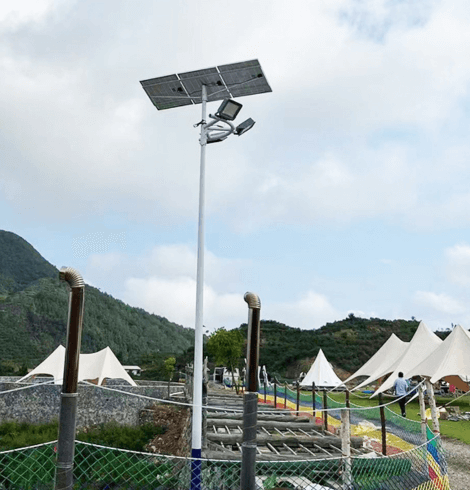
It might not seem as technical as a battery or controller, but the pole is a critical part of long-term reliability and safety. Most high-quality street light poles are made of Q235-grade steel and, when properly treated, can last more than 20 years. If they’re hot-dip galvanized and coated, the lifespan often stretches to 30 years or more — even in harsh environments.
Galvanization involves dipping the steel in molten zinc, forming a tough, corrosion-resistant layer. This process is especially important in coastal or humid climates, where untreated or poorly coated poles can begin rusting within a few years. Compared to a painted pole, a galvanized one stands up far better to the elements.
Why does the pole matter for long-term performance?
The pole is, quite literally, the backbone of the solar street light. If it fails, the whole unit could come down — and that’s not something any city or installer can afford to risk.
Fortunately, poles tend to outlast the electronic components. When built to spec and installed correctly, they provide a stable base for the solar panel, ensuring it stays aligned, and for the light fixture, ensuring consistent coverage. For municipalities or commercial projects, this makes pole quality a smart long-term investment that supports the rest of the system over decades.
Maintenance Tips
Even though poles require little upkeep, periodic inspection is a good habit. Check for signs of corrosion, especially around the base or areas where the coating might have chipped. If any rust does appear, touch it up promptly with a suitable anti-corrosion paint.
Also inspect the anchor bolts and foundation after severe weather. Wind, vibration, or impact can loosen hardware over time. Keeping bolts tight and checking structural stability ensures the system remains safe and secure.
If your poles include a powder-coated finish, an occasional wash can remove dirt or chemical buildup that might wear down the surface. It also helps keep the installation looking clean and well-maintained.
In short, poles might not demand much attention — but a small amount of care can go a long way in helping them deliver on their 20+ year promise.
Conclusion
Solar street lights are a long-term investment in sustainable infrastructure. If there’s one key point to remember, it’s this: each component has its own timeline, and understanding those timelines helps you manage the system more effectively. Instead of viewing the light as a single unit, think of it as a set of replaceable parts — most of which are built to last.
With routine cleaning, proper installation, and periodic checks, your solar street lights won’t just last — they’ll perform consistently, reduce maintenance costs, and support long-term sustainability goals.
If you’re responsible for managing outdoor lighting — whether for a city block or a private project — building with longevity in mind isn’t just smart. It’s essential.



